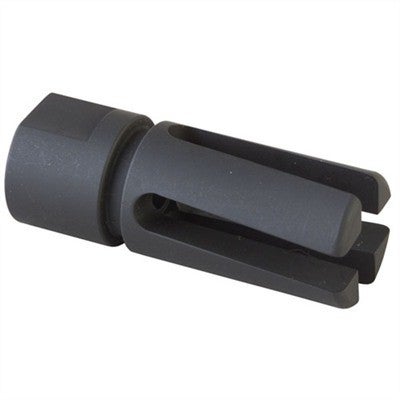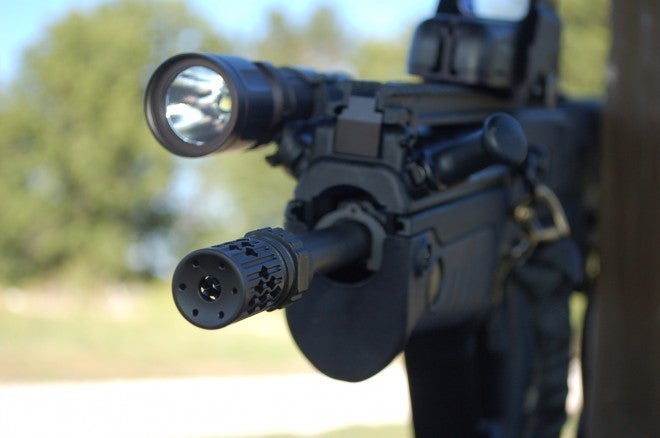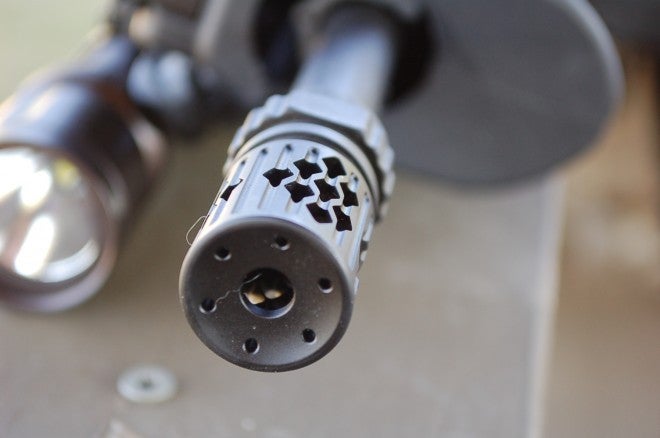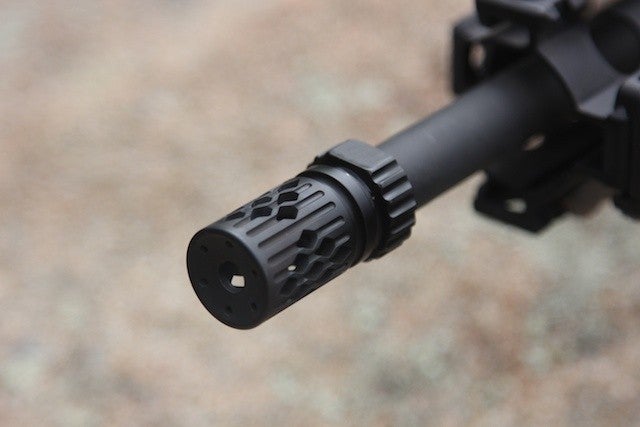I was out on the range last week talking with other shooters and the subject of flash suppressors and compensators came up. I was pretty shocked to find out a fair number of the shooters didn’t know the difference between the two. Yea you guys are more familiar with this subject than the average shooter but I was pretty shocked to hear that first “what’s the difference they all work pretty well”.
Ok everyone for those that don’t know the difference let’s cover that subject before going on to the new TSD Kompressor.
Basically a flash suppressor is just what it says. It suppresses the amount of flash created by the escaping gases/flame from the muzzle of a rifle barrel. This serves the purpose of hiding the shooter from an opposing threat. These are usually mounted on military type rifles.
A compensator usually doesn’t help much with flash suppression but does serve the purpose of reduction of muzzle rise when the rifle is fired. A good compensator will allow the shooter to keep the rifle on or near the original point of aim. The report is also a good deal louder than a flash suppressor.
The question is which is more important to the shooter. Do you want flash suppression or less muzzle rise and movement making follow up shots faster and on target? Most shooters it seems automatically use a flash suppressor. Believe me the compensator is well worth consideration.
For many years I’ve used the Smith Vortex flash suppressor. Before I retired from police service I carried my AR. When working a twelve-hour night shift having flash suppression was much more of a priority than muzzle control. The shooters who are involved in competition shooting the obvious choice would be a “comp” so they can shoot as quickly and accurately as possible. I’ll also use my Tavor as my primary carbine now. All testing was done with the Tavor using 62 grn green tip penetrator.
One last consideration is the difference in report between the two types. My Tavor with the Vortex is nowhere near as loud as when mounted with a comp. I remember the first time I fired an AR with a comp on it. I thought someone detonated a stick of dynamite! It was so loud it actually hurt. Cheapo hearing protection didn’t make much difference. I could actually feel the blast on my face as well.
To sum it up the need dictates, which type is most effective for the individual user. Now lets talk about the Kompressor.
The Kompressor is a new product that was released a short time ago by TSD Combat Systems. The retail website is One Source Tactical. The cost is $129.
As with all compensators quality hearing protection is a must. There’s no getting around it they are pretty loud. I can say the Kompressor is quieter than most I’ve used. If you want to compare decibel levels between muzzle devices download a decibel meter for your smartphone. These are free downloads if any of you have a desire or need for a meter. They can be downloaded on Google Play. In the case of the Kompressor the decibel level registered 95 Db average after firing 10 rounds.That decibel level is equal to the sound of a jackhammer at 50 feet.
As you can see from the photos the Kompressor has similar features to several other comps. I imagine it’s because it’s a proven design feature. The Kompressor uses diamond cuts rather than horizontal lines or a good number of small holes drilled throughout the comp. The bottom of the Kompressor has no diamond cuts or other openings. This feature serves two purposes. The first is with no bottom openings dust isn’t kicked up when firing. Dust being kicked up also gives away a shooters position. The other plus is there is no upward recoil pulse, which would defeat the purpose of the comp. The diamond cuts are placed on the top as well as the 3 o’clock and 9 o’clock position. The front of the Kompressor has six small holes.
Stats:
17.4 stainless steel
Rockwell hardness 42-45
Melonite surface coating
Multiple diamond vents
This video will give you an idea how effective the Kompressor is in controlling muzzle climb.
Conclusions:
I really like using the Kompressor rather than the Vortex. My concerns these days are faster follow up shots with greater accuracy. My first competition proved the Kompressor works and works well. My time was better and I was able to shoot smaller groups.
I’ve also gotten used to the increased muzzle blast to the point I pay no attention to it. The Kompressor also has less blast than most comps I’ve tried. The company claims the Kompressor also reduces muzzle flash. I agree it helps with muzzle flash. But it’s not a flash suppressor. My feeling is it does an excellent job doing what it’s designed for. Muzzle climb is very minimal making double taps much easier.
It’s really very simple the Kompressor works better than 99% of the ones I’ve tried and I’ll be leaving it on my Tavor.
The Kompressor is also available for the Sig 556, AK, Steyr AUG, AR15 and the Tavor.
 Your Privacy Choices
Your Privacy Choices







